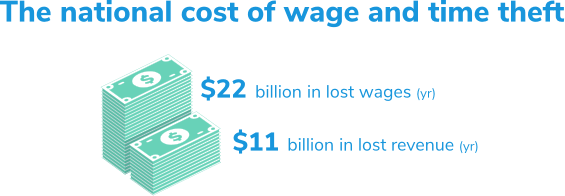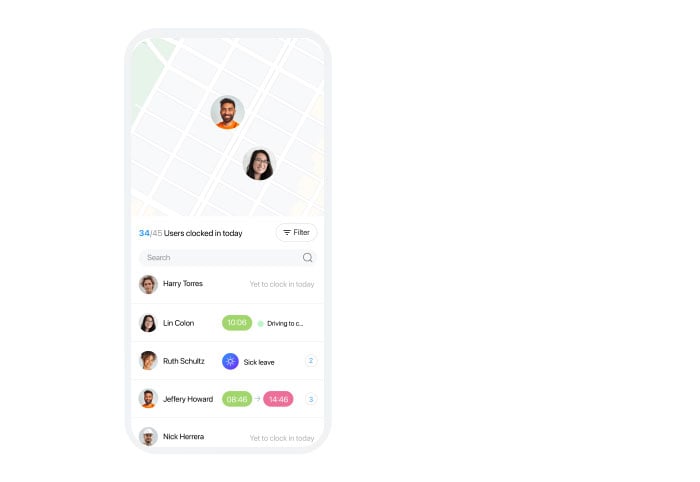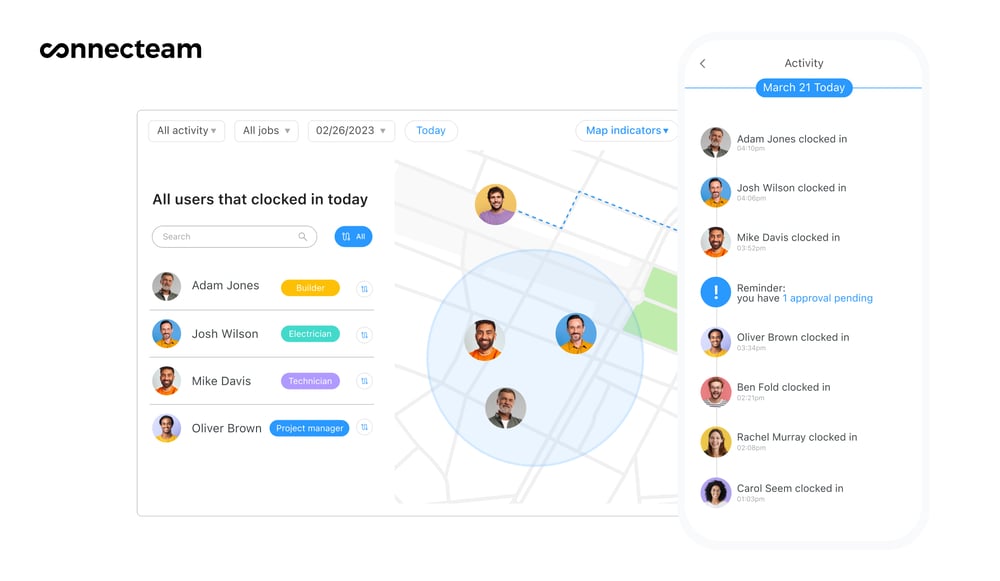Managers often brainstorm how they can make better use of their employees’ working hours. But, more often than not, this is easier said than done. Poor planning, too much downtime, inefficient time tracking, and time theft are far too common.
In fact, one of the biggest challenges of optimizing employee time all boils down to time theft.
The American Payroll Association (APA) found that 75% of businesses in the United States are affected by time theft every year. Additionally, this has lead to productivity losses of $400 billion annually as well.
What is Time Theft?
Time theft is exactly what it sounds like. An employee who is paid for the time they did not actually and genuinely work is time theft as it is flat-out stealing company time. It must also be noted that time theft doesn’t apply to any position or industry as all employee types may commit time theft.
The repercussions of employee time theft can cost you more than you know if you’re not careful. In this full guide on time theft, we dive into why it happens, how employees steal time, the costs, time theft laws, and how to prevent time theft.

Why Does Time Theft Happen?
When planning on how to curb time theft in your company, this is the first question you need to ask yourself.
To be quite frank, it generally happens simply because it can.
While only a small minority of employees actively seek out opportunities to steal, others will do so only if the right conditions arise. According to the “theft triangle” model, a staff member needs to have an opportunity, motivation, and reasoning in order to steal time.
To give you a practical example of how this model works: An employee knows that their manager won’t notice if they come into work 10 minutes late (opportunity). He or she is struggling to pay rent (motivation). The employee feels like they are underpaid (rationalization).
While tackling the motivational and rational aspects can be challenging, the best and easiest way to reduce or even eliminate time theft is to remove the opportunities.
Many business owners and managers are turning to automated time tracking solutions, like Connecteam, so they can record and monitor their employee’s time and attendance with complete accuracy in real-time.

Calculate the cost of employee time theft
2-week loss
Monthly loss
Yearly loss
Make better use of employees working hours
Connecteam’s Time Tracking app is able to see exactly where you stand so it’s easier to monitor your employee’s attendance.
How Employees Are Stealing Time
Buddy Punching
If employees have the opportunity to fudge their time cards or clocks, they’ll probably do it. For example, they’ll ask a trusted coworker to clock them in while they’re running late. This is known as buddy punching. In the United States, buddy punching results in employers paying $373 million in unnecessary labor costs annually.
By asking a coworker to clock you in, you are essentially skipping on a shift, whether it’s part of a whole shift. If an employee is clocked in but doesn’t arrive for another 20 minutes, that’s time theft.
Rounding Up
If your company tracks time on paper then that gives employees ample opportunity to lie about how many hours they’ve worked. Or if you allow employees to plug in their time via a program, like an Excel sheet, they can easily adjust their time.
Employees commonly round up their time. For example, if an employee leaves the office at 5:55, they’ll round the time up to 6:00 instead. After all, what’re a few minutes here and there? (Well, according to the numbers, employers in the United States lose out on $11 billion annually because of employee time theft.)
Extended Breaks
Stealing time at work may be caused by employees taking longer breaks than are allowed in the break time policy. For example, the employee may take a 45-minute lunch break but only marks 30 minutes on his or her time card. The same goes for taking excessive smoke breaks.
Read our guide on meal and rest breaks if you’re still unsure of what the policy should be.
Excessive Personal Time
When an employee is doing personal tasks or scrolling on social media, while on company time, that’s time theft. These matters should be done during their lunch break but instead are done while on the clock. For example, they’re on the phone paying their bills, organizing dates or childcare, are chatting with a friend, and so on. Or maybe they’re posting on social media like Facebook or Twitter. Or the employee could be playing games on their phone or texting family members. So even though they’re at work, the employee is definitely not working.
The Disappearing Worker
Employees can get super sneaky with time theft when they travel for their job. An employee may be sipping coffee at a cafe or buying a book at a local bookshop – all this while on the clock constitutes as time theft.
Early Starts and Late Finishes
An employee may clock in early but instead of getting right to work, they make a coffee or chat with a coworker about non-work matters. Or an employee may finish their work 15 minutes early but instead of clocking out, they pass the time until the official end of shift rolls around.
Now that you understand what the different forms of employee time theft exist, let’s discuss the costs of time theft to your business.
What Are The Costs Of Employee Time Theft?

When you really stop and look at how time theft is impacting your business, you’d be surprised how much a few minutes here and there cost you.
- The American Society of Employers reported that 20% of every single dollar earned is lost to employee theft in the United States.
- Another study reported time theft costs over $400 billion annually in lost productivity in the United States.
- Additionally, the average employee steals about 4.5 hours each week from their employer which totals almost six full work weeks annually and costs businesses billions upon billions worldwide.
- 56% of employers discover errors on nearly a fourth of employee timesheets.
- In the United States, buddy punching costs employers around $373 million annually.
- Accountants reported that 92% of their clients, regardless of industry, have a serious problem with time theft; on average, 5% is lost to gross payroll costs.
There are about a dozen more statistics we could have added here, but you get the point. Time theft can seriously damage your bottom line.
In a study, Software Advice asked shift workers how much time they steal in a single shift. Their response was:
- 1 to 10 minutes: 25%
- 11-20 minutes: 41%
- 21-30 minutes: 14%
- 31-60 minutes: 14%
- 61+ minutes: 7%
These startling results highlight how important it is for employers to be aware of the threat of time theft. It’s likely that the problem of time theft is costing you more than you may think.
How to Prevent Time Theft

Set Expectations
As you create a time theft policy then you must consider if an employee is stealing time at work, then it may be because they just don’t understand what’s expected of their job role. For example, if a restaurant server is texting friends because no customer is around them but you want them to be cleaning the tables or sweeping the floor – you need to be clear. At the same time you should consider the harmony of the workplace and find an inclusive prevention mechanism for not showing up on time with self-motivated employees.
Employees should understand exactly what their work duties are so they don’t waste company time. Don’t just ask them to do something, like “Can you sweep the floor?” As they may consider that a one-time duty. Instead, tell them that when they’re not helping customers then they need to be doing the following tasks (A, B, C, D, etc.)
This should be done from day one and can be readily available in the employee handbook under the time theft policy section. Clearly establish what the first day, week, month, and so on will look like for the employee, especially regarding their job role and responsibilities.
Use A Time Tracking Solution
Using employee time tracking software makes managing employee work hours so much easier.
Connecteam is a perfect example of a time and attendance system that allows employees to clock in and out from shifts using their smartphones. This makes time tracking accessible at any time, from any job location. Additionally, when an employee clocks in or out, their GPS timestamp is mapped as well so you always know when and where they were at the time that they clocked in or out.

Each employee has their own unique login making Connecteam a great solution for curbing buddy punching. Read more here as to why so many small businesses choose Connecteam for their time tracking needs.
- Geofence capabilities ensure employees aren’t able to clock in at all when they aren’t in the working area
- Time clock limitations ensure employees can’t clock-in earlier than they should, even if they decided to show up early and THEY ARE at the job site, just waiting for their shift to start
- Automatic clock-out helps to ensure employees don’t “forget” to clock-out or just stay at the worksite a bit longer for no reason to grab a few more minutes every day
- Real-time notifications alert you to employees who are still clocked-in, employees who were automatically clocked-out, and more so you, as a manager, know exactly what’s going on in the field
- Set locked days on the app – it means that an admin with the relevant permission reviewed the hours for that day and approved the hours for payroll
- Receive alerts if an employee clocks in with a new device. If an employee clocks in with a different phone model or version (or even a different Connecteam app version) then the manager will be alerted because this signals that either your employee bought a new phone or has asked someone to log into their user in the app.
Additionally, via the mobile app, employees can request time off, view current or past timesheets, and even export them to Connecteam’s QuickBooks Online or Gusto integration for 100% accurate payroll, can communicate with you via the in-app chat, can add detailed notes to a shift, and so much more.
Connecteam gives you, the manager, all the tools you need to make sure that your employees are only working at the time they are supposed to and provides you with all the information you need at all times so that establishing and following through on your time theft policy is easier to manage.
Curb Employee Time Theft With Connecteam
Free 14-day trial, no credit card needed
Establish Clear Rules
Via your code of conduct for the time theft policy, clearly state what the rules are regarding clocking in and out. As a manager, it’s obvious to you that clocking in for a coworker is a no-no or that playing games on your personal phone while clocked in is considered time theft, however that might be obvious to everyone else.
Employees don’t always stop and think about what the consequences are of their behavior and how it’ll damage the company’s bottom line. Plus, the integrity of the employee and their coworkers is seriously damaged as well.
So, write it out in your code of conduct and employee handbook to make it clear what the time theft policy is. Hand signs and posters all over the workplace. Include a message in the time clock app. Have a monthly meeting to remind everyone of the rules.
Whatever method you use, always be proactive and ensure everyone is up to date on the time theft policy.
Plus, ensure you’re following the rules when it comes to tracking your employee’s hours.
Follow Through on Disciplinary Actions
There is no doubt that managers have a lot of tasks to juggle and sometimes, things fall through the cracks. However, if you let time theft go unchecked, you’re sending your employees the wrong message. Therefore, it’s vital that you follow through on your disciplinary proceedings when someone commits time theft.
For example, if time theft is committed and caught, you may follow these guidelines to handle the matter: Verbal warning, written warning, suspension, and termination. Write this out in your time theft policy so that employees know what will happen and when.
However, ensure that all offenses are reviewed before reprimanding an employee. For example, you catch an employee taking selfies while no customers are around, instead of giving a formal verbal warning or writing them up, talk with them to remind them of the rules. Make sure they understand what duties they should be on top of if no customers are around. There’s a huge difference between clocking in two minutes early and taking a two-hour lunch break. Be clear on the time theft policy for all circumstances.
What Are Time Theft Laws?
Most employers who are victims of time theft have a rather difficult time making a case against employees stealing time at work. According to the Fair Labor Standards Act (FLSA), the employer is required to pay for the hours worked by the employee (which is typically reported via a time card or timesheet). If an employer refuses to pay for hours worked that they believe were incorrectly or falsely reported, then the employee can file a suit against the employer for two times their back wages, including attorney and court costs.
When supporting your claim, the following steps are key:
Be Thorough
Findlaw.com states that an investigation can only be fair if it follows specific guidelines. The investigator should be someone who did not discover the time them, maintains strict confidentiality, gets help from an attorney, and finally, the investigator must interview the employee while in the presence of witnesses. However, this can only be done after all evidence has been collected.
Create a Plan for Disciplining the Employee
Speak with legal counsel to best decide if you should suspend the employee, put them on probation, or terminate their employment.

Seek Compensation
While working with your attorney and insurance company, you may be able to recover losses incurred. Make sure you fully examine your insurance policy to understand if time theft loss is covered. If it is, then ensure you follow procedures when it comes to filing a claim. Although your attorney may advise that you pursue litigation in order to recover losses in a civil court or even through the criminal justice system.
However, it is absolutely vital that if an employee files a claim that they have not received all the wages owed then the FLSA absolutely prohibits employers from retaliating against them. Therefore, if you respond to the lawsuit with a claim for time theft, the FLSA would consider that as retaliation – unless you can 100% prove that said employee intentionally committed time theft.
Discover more resources available by the FLSA here: employers, workers, and state and local governments. Always refer to the FLSA rules and guidelines, via their website, you can find the appropriate individual to speak with that’s in your area. Additionally, don’t just jump to conclusions – remain calm and gather all the facts then speak with a lawyer on the next steps so you can avoid a hefty lawsuit yourself. Time theft laws and regulations are touchy so make sure all your bases are covered before jumping head in.

Wrapping Up Our Guide on Time Theft
Employees stealing time at work does happen, and quite often too, even if you’re not aware of it. And maybe your employees aren’t even aware that what they’re doing is time theft! By understanding what time theft is and what time theft laws are, you and your employees will be better prepared in the long term and can avoid any nasty disagreements and lawsuits. In addition, by using time tracking apps, you’re able to see exactly where you stand so it’s easier to monitor your employee’s attendance.
Our guide outlined above serves as a great starting point for creating a time theft policy but it’s vital that you everyone know what happens when time theft is detected and remain current on all rules and regulations as they can change at any given moment.
The Leading Time Clock App
Easily track employee work hours, streamline payroll process, and more!




